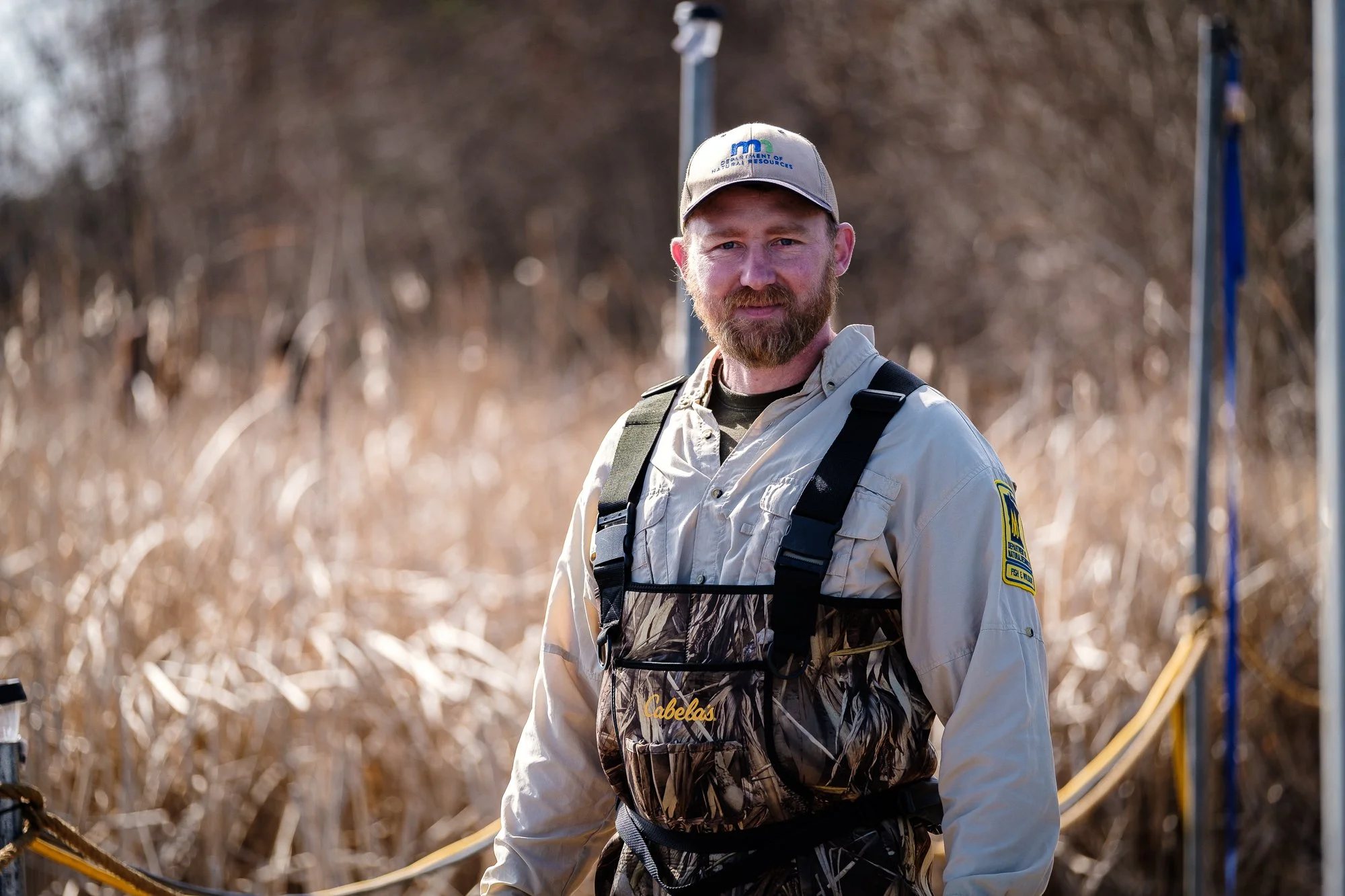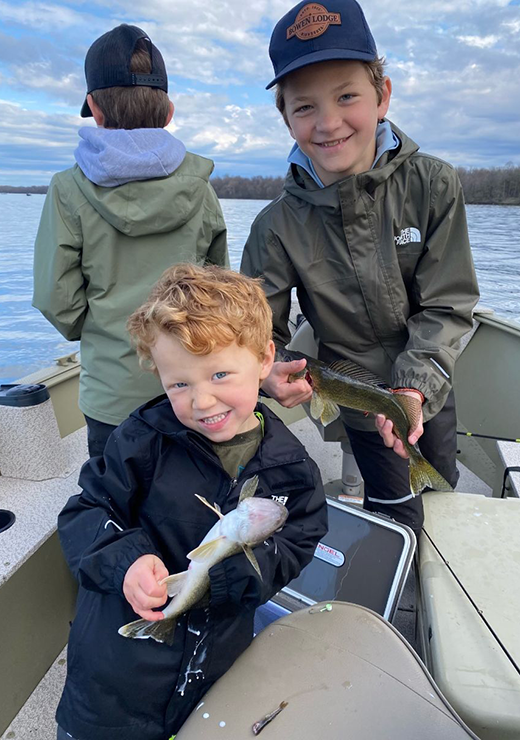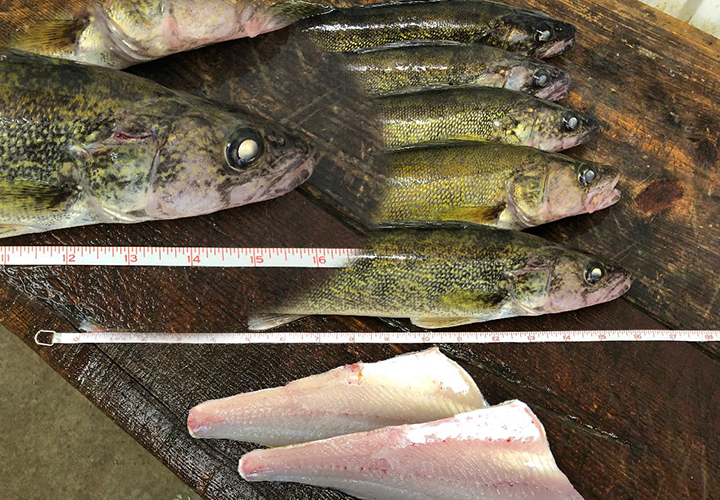Since the beginning of the season, most of our guests have headed out to the big lake, taken a left, and worked Tamarack Bay’s most popular springtime locations. But this week, strong winds from the west have challenged anglers with that plan in mind, for those who can get where they’re going, walleye fishing has generally been good. But for the rest of us, Cutfoot Sioux has offered both protection from the elements and an opportunity for a more diversified creel.
Water temperatures in Cutfoot are somewhat warmer than on Lake Winnie, 59 to 62 degrees in Cutfoot vs Winnie’s 57-to-59-degree readings. Water levels have receded a few inches, but are still unusually high, even for early season. The combination of high water and low temperature are holding fish back from some of the “summer peak” locations and patterns. But fish can be caught, provided anglers make adjustments tailored to the fishes’ activity levels.
One of the keys to productive fishing on Cutfoot this week has been to fish during low-light periods. An early riser can catch both walleye and crappie, then return to the cabin for breakfast before most folks have started their fishing day. The evening feeding runs have also been productive. Again, both crappie and walleye cruise the shoreline where submerged vegetation is beginning to turn green. Key depths range from about 6 feet, down to as deep as 12 feet. During the twilight periods, fishing water deeper than that is usually unnecessary.
mixed bag meal of nice perch, crappie and walleye from Cutfoot Sioux
For most folks, anchoring the boat and fishing with slip floats is the standard. A 1/16-to-1/8-ounce jig, tipped with small fatheads and suspended about 18 inches above bottom works well. Anglers who prefer a more “hands on” approach can use their electric trolling motors to creep along the weed edges. For walleyes, casting small jigs tipped with larger minnows makes the most sense. Action tails like twisters, shad bodies or split tails provide better results for crappies.
Daytime anglers are beginning to find more perch of quality size. Spawned out by now, expect to find long-but-slender females mixed in with schools of smaller, often hungrier males. Numbers of good size fish, 10 to 12 inches, remain modest, but folks are getting enough to make the pursuit interesting.
Prime perch locations for now, will be vegetation emerging in the shallows or over soft bottom flats or adjacent to deep structure. The depth range is all over the map, anywhere from 2 feet of water to as deep as 28 feet. That’s because most of the better perch seen caught this week have shown strong evidence that insects are the preferred food source over either minnows or crawfish. Insect hatches tend to hold perch in an area longer than minnows, so once located, your spot should be good for a few return visits.
Use small jigs tipped with fatheads or leeches to trigger strikes. Plastic, perch imitating tails will produce too, so experiment them too.
Walleye anglers who are fishing on the big lake have begun catching fish in a wider variety of locations. There are still healthy populations of fish on shoreline related breaks, the depth will vary with conditions. On windy days, 6 to 12 feet of water is productive. Calm waters send the fish deeper, 18 to 26 feet deep at the base of shoreline connected structures.
Steep breaklines, like the ones found along the Mississippi River channel are holding fish, but those are overwhelmingly fish from Winnie’s strong 2019-year class. When you get into a school of 12-1/2 to 13-1/2 fish, it is unlikely that you’ll find good numbers of “keepers”.
This spring, leaving the small fish behind and moving to another spot can pay off bigtime because another strong year class, 2018, features good numbers of fish that have matured. Some folks are setting a voluntary 15-inch minimum harvest size and having no problem bringing some fish home for the table. In fact, there are healthy numbers of 16 inch fish from that year class showing up too.
For folks who enjoy catching photo and release size fish, some of the lakes larger, mid-lake bars are binning to produce now too. Insect hatches are the draw, so softer bottom areas located adjacent to structure will produce best. Most fish have not migrated to the center of the big lake, stick with deep water structure that is connected to the shoreline,
For now, jig and minnow presentations continue to produce fish, even on the bars. But Lindy Rigging with leeches and night crawlers are gaining in popularity. As the weather warms, live bait rigs will become increasingly effective.
Panfish anglers, expecting to find fish on shallow water spawning beds have been disappointed so far. But with water temperatures teetering on the verge of ideal range, it could change soon. Remember that panfish regulations have changed, Cutfoot and Little Cutfoot Sioux have been brought into “Minnesota’s Quality Sunfish Initiative.” It is scientifically proven that being protective of a lake’s largest sunfish helps guarantee that they will flourish. We’d love to see that for our lakes, and we hope you do too.
If you’re in the neighborhood, stop by for a chat. Otherwise stay in touch, we’ll be back again next week with a fresh report.





















